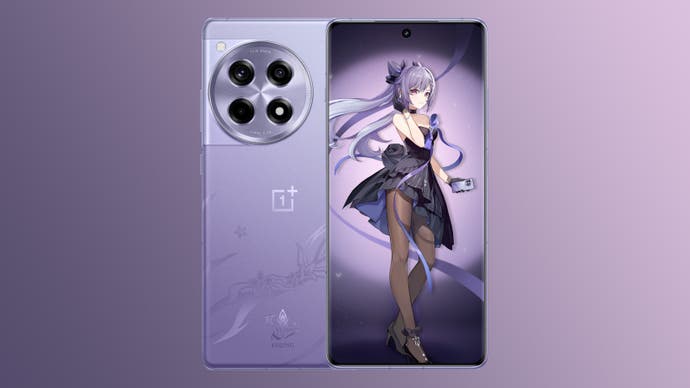OnePlus 12R Genshin Impact Edition review: flagship-grade power with plenty of fan extras
One of the most interesting video game tie-ins in a while.
Genshin Impact is one of the most popular games in the world and perhaps China's chief video game export, but even knowing that I was surprised to learn that domestic compatriot OnePlus has created a special £699 Genshin Impact Edition of their (£649) 12R smartphone. Not only that, the phone is based around a single character from the game - the purple-haired Keqing - who I imagine must have been selected as the face of the brand after quite a bit of research.
The Shenzhen-based outfit offered to send over a unit for review, and I thought it might be an interesting way to check out both one of the most affordable phones to ship with last year's performant, flagship-grade Snapdragon 8 Gen 2 chipset - and see what one of the most unusual game tie-ins I've ever seen actually provides for fans in terms of performance, design and extras.
Design

The OnePlus 12R Genshin Impact Edition has a bold look, taking what was already quite a premium looking phone for its category in the vanilla 12R and making it quite a bit more eye-catching. The purple 'electro violet' colourway catches the light nicely, especially with the jewelled appearance of the rear camera array, and the purple look extends to the metallic frame around the device too.
This is certainly a slippery phone to hold, so you may want to use a case - though a transparent design is surely the only correct choice here, given the work that's gone on into shaping quite a unique look. The phone also has IP64 water and dust resistance, which is nice to have but not competitive with flagship phones that tend to be IP68 rated these days.
As well as the phone itself, you also get an entire case of themed accessories - stickers, pins, case, charger, USB cable, SIM ejector tool, even a whole miniature backdrop, character stand and chibi-sized phone stand for taking pictures of your phone in. If you're a fan of Genshin Impact's excellent artwork, and particularly of Keqing's portrait featured on the rear of the case, this is quite a nice value-add if you have the space to display it all.

Display
While its exterior design has been heavily changed from the vanilla OnePlus 12R, the display remains the same on this Genshin Impact edition. That means a 6.8-inch 1264x2780 LTPO4 AMOLED screen that can vary its refresh rate from 1Hz to 120Hz, providing a responsive gaming experience without trashing battery life as early 90Hz and 120Hz models sometimes did. The touch response rate is also impressively high at 1000Hz, which ought to confer some benefits in responsiveness - and indeed I've no complaints.
The screen is vividly bright too, and is rated for 4500 nits of peak HDR brightness with Dolby Vision support. Suffice it to say that the screen is a real highlight of this device, easily capable of overpowering sunlight outdoors or delivering impactful highlights in HDR content.
Underneath the screen is an optical fingerprint sensor that worked rapidly in my experience, though facial login is also offered courtesy of the hole-punch selfie camera and this was often faster.
Camera
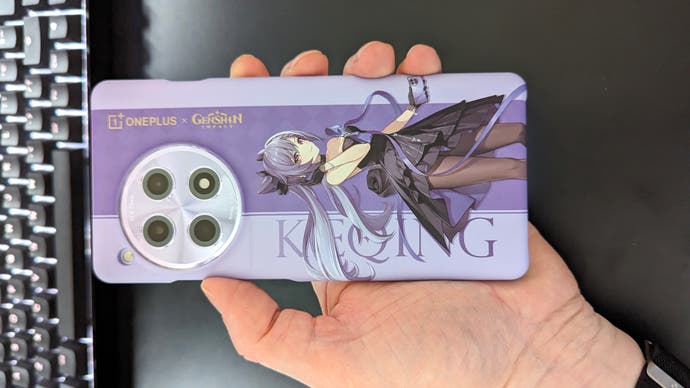
The OnePlus 12R comes with the same 50-megapixel Sony IMX890 sensor as last year's OnePlus 11 flagship, but this is backed by a more pedestrian eight-megapixel ultrawide lens and a largely useless two-megapixel macro mode that's just there to make up the numbers. Up front, there's a 16-megapixel wide-angle lens.
Performance from the primary shooter is strong, providing comparable results to the iPhone, Pixel and Galaxy smartphones of a few years ago, but OnePlus feels a few steps behind the best of the competition in 2024. Optical image stabilisation and binning from the large Sony sensor allow for quite detailed 12.6-megapixel shots, especially in good light, and colour tuning and dynamic range are quite good to my eyes. There's also the option for full 50-megapixel stills, RAW HDR shots and video up to 4K 60Hz.
The camera interface here will be quite familiar to Pixel users, with a few extra options for retouching faces and applying filters but fewer AI tools than on recent Google flagships.
I wouldn't say that the OnePlus 12R is a terrific camera phone, but it's not a weak point either and performance feels reasonable given the price.
Performance and software
The OnePlus 12R is one of several phones that we've tested recently with the Snapdragon 8 Gen 2, a flagship-grade chipset that debuted in 2023 but is present in quite a few phones whose (Western) release dates have slipped into 2024. This chipset is backed by 16GB of RAM and 256GB of storage, so you are at least getting a better-equipped phone than the base-spec 8GB/128GB OnePlus 12R sold in other regions.
Performance here depends greatly on the performance mode that you use, with the 12R Genshin Impact Edition recording single-core scores of ~1000 regularly and ~2000 in its high performance mode. This high performance mode is engaged automatically if "championship mode" is enabled in the phone's game launcher, or can be manually toggled in the settings, and results in lower battery life and higher thermal output as you'd expect.
At max power, the 12R is consistent with other phones using the same chipset, only notably outperforming the Honor Magic V2 RSR in GeekBench 6 and the Sony Xperia 5 V in PCMark Work 3.0.
| Benchmark | OnePlus 12R | Sony Xperia 5 V | Honor Magic V2 RSR |
|---|---|---|---|
| Geekbench 6 Single Core | 2019 | 2069 | 2030 |
| Geekbench 6 Multi Core | 5438 | 5585 | 4928 |
| 3DMark Wild Life Extreme | 3694 | 3725 | 3748 |
| PCMark Work 3.0 | 14075 | 12466 | 14089 |

Beyond its unremarkable peak performance, it's important to discuss how performance changes over time, most notably as the device heats up in an extended play session. This can be simulated with the 20-minute 3DMark Wild Life Extreme stress test, which reported a peak score of 13K that dropped to 8.5K by the 14th minute of the test, where it remained to the end. High performance mode only improved these scores by around 200-300 points each, suggesting that we're dealing more with thermal constraints than power limits intended to boost battery life.
The OxygenOS 14 interface built atop Android 14 is relatively close to a stock experience, with a few annoying preinstalled apps and a few genuinely useful features such as the game mode launcher. This Genshin Impact Edition is themed purple throughout, matching up with the physical design and provided accessories, and of course you're free to set a cleaner theme and/or use an alternative launcher if you prefer.
In terms of the game launcher, this includes suggestions of downloadable games to try, a somewhat questionable list of all games installed on the phone (which, for me, included such highlights as food delivery service Just Eat and ticket app Trenitalia) and the aforementioned championship mode. This latter option is interesting, as it silences alarms and notifications as well as boosting performance, refresh rate and touch rates to their maximum to ensure you're not interrupted in a critical point of your favourite game.
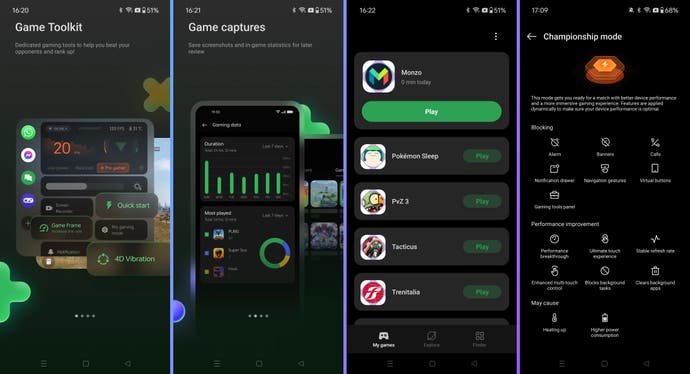
My Digital Foundry heart was also warmed by the inclusion of a live frame-rate readout with CPU and GPU utilisation stats in the game overlay, though OnePlus ought to include an optional FCAT border if they want the full-fat DF experience. You can even adjust GPU settings such as engaging VRS, setting MSAA, AF and Mipmap LOD Bias - suffice it to say that I've alerted Alex Battaglia about these exciting possibilities!
Other features include screen recording, floating windows for communication apps like Discord, a voice changer, 'hyper HDR', automatic adjustment of game resolution based on battery and thermals, colour filters for PUBG Mobile, rapid startup for 'games you freqently play', 4D vibrations to 'enhance your gaming experience' and much more besides. Some of this is dross, but I wish I had quite a few of these features on the Pixel 6 that I daily drive.
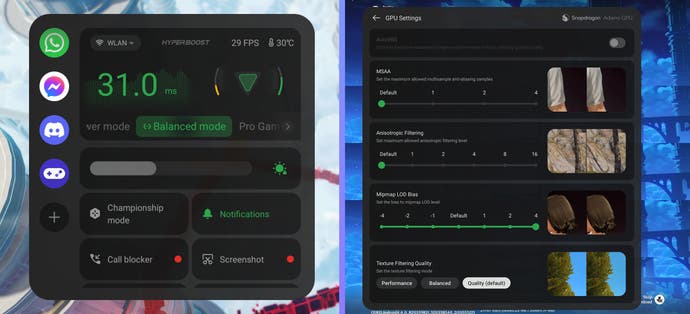
Battery life
The OnePlus 12R comes with a capacious 5500mAh battery which proved more than sufficient to handle two relatively full days of useage, with a purple-coloured power brick and matching USB-C cable provided. Fast charging is supported up to 100W (!), which can reportedly top up the phone from empty in just 26 minutes. Wireless charging isn't included, which didn't bother me but might be a deal-breaker for some.
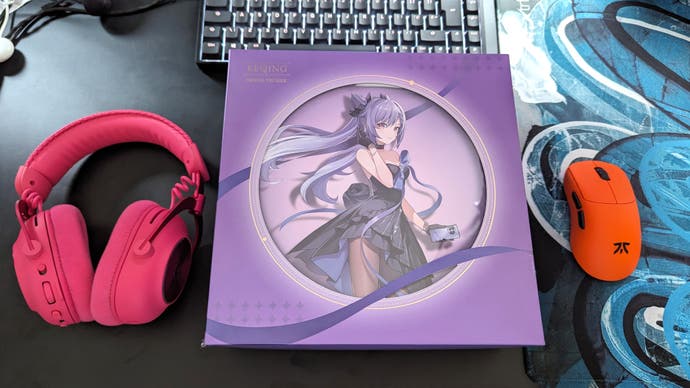
Conclusion
The OnePlus 12R Genshin Impact is an interesting phone that will no doubt appeal to fans of the popular game - most of all the Keqing stans given that her colour scheme informs the phone's design and her likeness is reproduced on the phone case and many other accessories provided. Given that all of this comes at a relatively modest £50 premium over the default £649 OnePlus 12R, I'd say that it's a fair value for what you're getting.
The OnePlus 12R itself also feels like a reasonable investment compared to the other Snapdragon 8 Gen 2 phones that we've looked at recently, most notably the Sony Xperia 5 V. This competitor did come out in the final quarter of 2023, but remains at £799 for a model that comes with half the RAM and half the internal storage. The 5 V admittedly has some unique features, including a more compact design, Micro SD card slot and headphone jack, but the OnePlus 12R feels like a better package overall at £649.
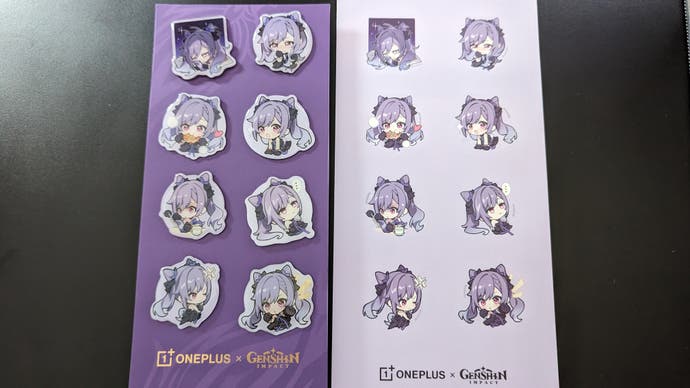
Truth be told, there's no shortage of phones with the same chipset or the faster Snapdragon 8 Gen 3, but the OnePlus 12R is certainly an intriguing option given that it is amongst the most affordable handsets for the flagship-grade level of power it provides.
Despite that aggressive pricing, its performance and camera are competitive, with what I would class as genuinely useful gaming features, extremely strong industrial design and a brilliant display. If that combo sounds appealing, the OnePlus 12R is well worth considering - with the Genshin Impact Edition representing a nice additional colour choice with some fun accessories at a slight premium.
